We traveled to an RV park in Mims, FL, which is just above Titusville in an area they call the Space Coast. I'm sure most all of us have purchased citrus fruit from Indian River, FL, and maybe, like me, pictured a lazy stream meandering its way through the acres of fruit trees. Wrong! The Indian River is huge and very beautiful.
 |
| This is the bridge that spans the Indian River as you go towards the Kennedy Space Center. |
 |
| It looks like you are on the ocean but it is actually a part of the intercoastal waterway. |
 |
| A wonderful area for fishing and boating. |
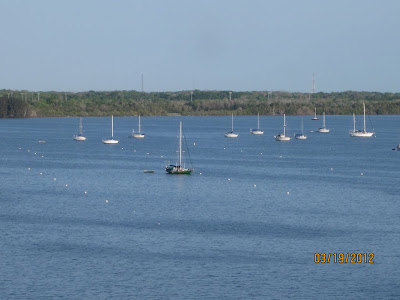 |
| These boats were anchored on the river. You can see the buoy lanes in the water. |
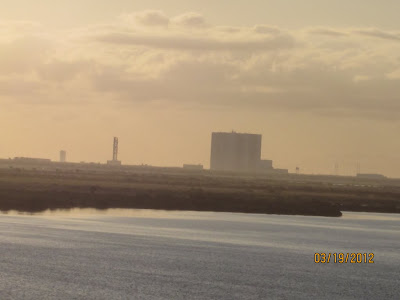 |
| Kennedy Space Center early morning from the bridge. One of the launch pads is to the left. |
 |
| What a break.......we were there just in time for a launch. |
 |
| Actually.....it was the sunrise but it sure looked authentic, didn't it! |
 |
| Here we are at the Kennedy Space Center Visitors Complex. |
We purchased the tickets for $43 each but had the opportunity to upgrade to an annual pass for an additional $7 each. Since we knew we would be going there several times we purchased the annual pass and had our pictures taken and wore identification on a lanyard saying we were members of the Commanders Club (shazam!). That way we didn't have to dig out our ticket when we went on specific tours and we also received a small discount for food and other purchases.
The Kennedy Space Center is amazing and there is so much to see and do that you can easily take up several days. It is also very technical. We spent a good deal of time on the Saturn V / Apollo Space missions and wanted to share some of the information with you.
 |
| Note above the entrance gate there are astronauts in space. |
 |
| This is a topography of the Kennedy Space Center. Note the body of water on the left is the Indian River and on the right it is the Banana River and then the Atlantic Ocean. The Banana River is an environmental site that is closely protected. No power boats are allowed so the manatee and many other endangered species have flourished. |
 |
| A full scale mock up of the shuttle. |
 |
| The last launching pad used for the shuttle missions. |
Apollo / Saturn V
The Saturn V served as the launch vehicle for the Apollo spacecraft and was composed of three main sections known individually as the S-IC, S-II and S-IVB stages. The rocket's Instrument Unit (IU) was stacked atop the third stage.
The Apollo spacecraft was made up of three main components, the Lunar Module (LM), Service Module (SM), and Command Module (CM). The vehicle's Launch Escape System (LES) was attached to the tip of the Command Module.
In the picture below, the S-IC stage was responsible for launching the 6.2 million pound Apollo/Saturn V vehicle. The five F-1 engines at the base of the S-IC propelled the spacecraft to a speed of 5,000 mph and consumed fuel at a rate of 15 tons per second. Approximately 2.5 minutes after launch,the engines cut off and the stage was jettisoned into the Atlantic Ocean.
 |
| The five F-1 engines at the base. |
After separation of the S-IC stage, the Saturn V's S-II stage ignited to propel the spacecraft to a speed of 15,000 mph. Producing a combined thrust of 1,125,000 pounds, the five J-2 rockets at the base of the S-II stage boosted the rocket 100 miles above the Earth. The S-II burned for about 6.5 minutes and was also jettisoned into the Atlantic Ocean when it's fuel was consumed.
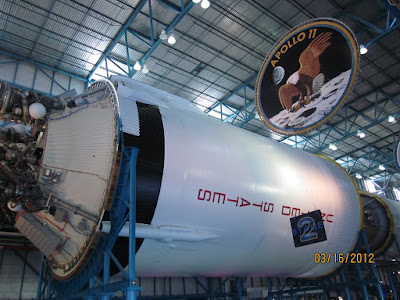 |
| This is the second stage rocket. |
Powered by one J-2 engine, the Saturn V's S-IVB stage propelled the spacecraft into Earth orbit by accelerating it to a speed of 17,400 mph. The engine was fired for a second time after the vehicle had completed approximately three orbits of the Earth. Upon reaching a speed of over 24,000 mph, the spacecraft entered its trajectory toward the Moon. The third stage of Saturn V is similar in structure to the rocket's second stage.
 |
| The third stage taking the spacecraft into orbit. |
 |
| The top end of the third stage rocket. |
Referred to as the brain of the Saturn V rocket, the Instrument Unit (IU) contained guidance, navigation and control devices used to steer the spacecraft. It also regulated tracking, communications, electrical and environmental systems. The IU was designed and manufactured by IBM and was powered by four 28-volt DC batteries.
The Spacecraft-LM Adaptor (SLA) located above the IU protected the Lunar Module (LM) during launch and until separation of the S-IVB stage. Once the S-IVB had placed the spacecraft on a trajectory to the Moon, the Command and Service Module (CSM) turned around and extracted the Lunar Module (LM) from the SLA.
 |
| This little ring is the Instrument Unit (IU) or the brains of the Saturn V rocket. |
The Service Module (SM) was never inhabited by the Apollo astronauts. It was, however, one of the most important components of the spacecraft. The SM carried the spacecraft's main engine and provided the Command Module (CM) with oxygen,water, and electricity.
The Service Module consisted of a core section surrounded by six pie-shaped bays. The main engine was located in the core while the bays contained propellants and subsystems for electrical power, environmental control, communications, and reaction control. Three fuel cells located in the SM generated electricity for the spacecraft by means of a chemical reaction involving oxygen and hydrogen. The reaction also provided water which was pumped into the Command Module (CM) for the crew to drink and mix with their meals.
 |
| The Service Module (SM). |
The Command Module (CM) was the only Apollo/Saturn V component to return to Earth. Functioning as a cockpit, office, kitchen, bedroom, and bathroom, the CM was home to the three astronauts except when two of the crew members visited the Moon in the Lunar Module (LM).
The Launch Escape System (LES) at the tip of the Apollo/Saturn V was designed to separate the CM
from the rest of the rocket in the event of a launch emergency. It was jettisoned approximately 30 seconds after the ignition of the S-II stage.
 |
| The Command Module (CM) where the astronauts lived. |
 |
| The Launch Escape System (LES) at the tip of the Command Module to jettison the CM away from the rocket if the launch had to be aborted after the S-II stage. |
 |
| What the whole thing looks like put together. Note on the top right the little tiny section notated as the CM........the Command Module where the astronauts lived. |
 |
| This is an electrically powered demonstration model of the Moon Buggy. |
 |
| The control panel of the Moon Buggy. |
 |
| NASA designed this hand cart to help solve the problems astronauts had in previous missions carrying hand tools on the Moon. |
Some other neat things we saw at the Kennedy Space Center, in no specific order:
 |
| The Command Module (CM) from one of the Gemini missions. Hard to believe anyone could live in this thing. |
 |
| An astronaut space suit. |
 |
| The original space suits were very uncomfortable because the material was much harder than what they use today. |
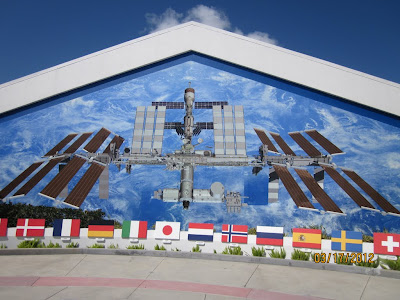 |
| A beautiful mural of the international space station and flags of all the countries that are working together with the United States. Those countries are Belgium, Canada, Denmark, France, Germany, Italy, Japan, Netherlands, Norway, Russia, Spain, Sweden, Switzerland, and the United Kingdom. I'm glad we can at least get along out in space. |
 |
| The Rocket Gallery. |
 |
| The Command Module for the Mercury astronauts. You had to lie down in it but even still.........how could they stand it???? |
 |
Engineers and technicians worked here in the Mercury Control Center from 1961 to 1965. At these consoles NASA personnel directed all six of the Mercury missions and the first manned Gemini mission.
|
 |
| Why launch from Florida? NASA chose the east coast as its launching port because of its proximity to the Atlantic Ocean, because the area was relatively unoccupied at the time of NASA's inception, and because of the Earth's rotation on its axis and how close Florida is to the equator. As the planet spins, the speed of rotation is greatest at the equator and lessens as you move further north or south. As a result spacecraft launched from Kennedy Space Center are given over 900 mph of additional boost, saving fuel and increasing efficiency. |
Wow! That sure made my head hurt! And if that wasn't enough we also went for an air boat ride on the St John's river. What a blast!
 |
| Looks just like the Everglades. |
 |
| Lots of birds. |
 |
| An occasional tree here and there. |
 |
| Looks like a prehistoric bird as it takes off. |
 |
| These little guys would run across the water before they took off. |
 |
| Beauty in flight. |
 |
| And there were some other prehistoric critters. |
 |
| This guy was smiling for Brett. |
 |
| They were afraid of the noise from the air boat so many took to the water. There are easily six in this picture that we saw. |
 |
| This is a roseate spoonbill. |
 |
| Its coloration was breath-taking. |
 |
| And very graceful as it flew away from us. |
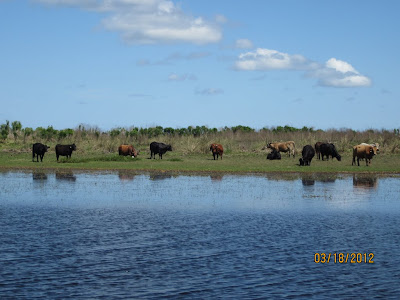 |
| And then, of course, there was the cattle. We even saw several cows that had walked through the water to a small island to graze. |
 |
| The alligators were lurking everywhere but all the critters seemed to get along somehow. |
 |
| The guy taking us on the tour said to not be afraid if we fell into the water because it was not very deep. He said to just stand up. He didn't mention what to do, though, if there were alligators nearby. We all hung on real tight. |
 |
| Another different looking bird standing in a yard. |
Finally yes, you know, we have to finish with the pups and their day at the beach. There were lots of dogs.........as always.............
 |
| A pretty Goldie........ |
 |
| An adorable Lab that loves to stick its snout in the sand......... |
 |
| And a pig. That's right, a pig. It was at the beach with all the other pups. It thinks it is a dog and it likes to play with other dogs. Max and Lucy were curious and nervous and even a little afraid. We didn't stick around too long. |
That's it from the Space Coast. We are heading to High Springs, FL, which has a lot of parks and hiking trails. Time to get back to nature. Peace to all!

























